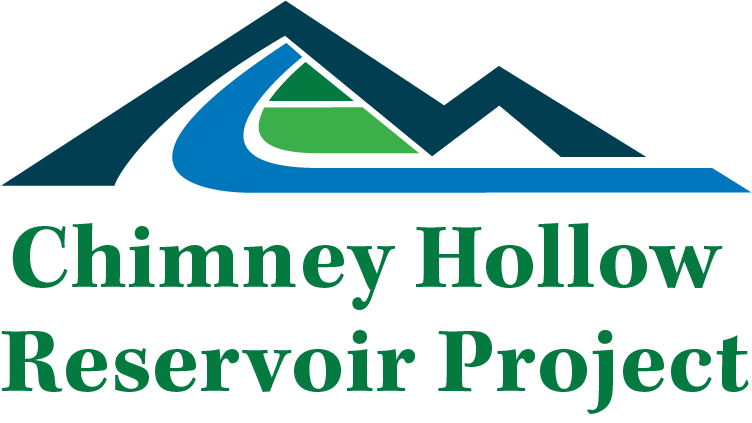Inlet/Outlet Works
Getting Water In and Out of Chimney Hollow
Chimney Hollow Reservoir’s location adjacent to C-BT Project infrastructure will enable water to easily be moved in and out of the reservoir when C-BT Project capacity is available per an agreement with the U.S. Bureau of Reclamation.
The process of getting water to Chimney Hollow Reservoir begins on the West Slope. Just west of Granby sits Windy Gap Reservoir, where water is collected and pumped six miles via pipeline to Lake Granby. From there, existing C-BT Project infrastructure conveys Windy Gap water through Shadow Mountain Reservoir and Grand Lake to the Adams Tunnel, which passes under Rocky Mountain National Park.
After traveling 13.1 miles through the tunnel to the East Slope and then through four reservoirs and three power plants, water will make its way in and out of the Chimney Hollow Reservoir through the inlet/outlet works, which includes C-BT Project interconnections, the conduit, valve house, the inlet/outlet tunnel and the inlet/outlet tower located within the right (east) abutment. From Chimney Hollow Reservoir, water is released into Flatiron Reservoir where it can be delivered to the 13 participants using the existing C-BT distribution system that spans across northern Colorado.
Colorado-Big Thompson (C-BT) Interconnects
One of the reasons the Chimney Hollow Reservoir is such a great site is because of its adjacent location to the C-BT system, which allows us to easily move water in and out of Chimney Hollow Reservoir using existing infrastructure. Through an agreement with the U.S. Bureau of Reclamation, the Municipal Subdistrict can allow water to flow into Chimney Hollow Reservoir when there is available capacity in the C-BT Project infrastructure.
In order to fill Chimney Hollow, construction crews tapped into the Bald Mountain Tunnel and installed a steel wye. The wye is encased in concrete and affixed with a butterfly valve so that Chimney Hollow Reservoir can be isolated from the C-BT Project if necessary.
Delivery of Chimney Hollow water to our southern participants will be done by releasing water from the reservoir into Carter Lake by tapping into the Carter Lake Pressure Conduit with another steel wye. Our northern participants will receive water from Chimney Hollow Reservoir as it is released into Flatiron Reservoir and then north through existing delivery canals and pipelines.

Chimney Hollow Conduit
The Chimney Hollow Conduit consists of about 1-mile of buried steel pipe that will bring water from the existing CB-T Project infrastructure into Chimney Hollow Reservoir. The pipe will be buried and will be able to deliver water into Chimney Hollow Reservoir. The Chimney Hollow Conduit also provides an alternative, backup, way to fill Carter Lake.
The heaviest section of pipe weighs 33,650 pounds. As water travels downhill from the Bald Mountain Interconnect, the weight and thickness of the pipe increases to compensate for the rise in pressure as the water flows down by gravity. At the top of the hill, the water pressure will be about 36 pounds per square inch (PSI), whereas at the bottom of the hill (at the onsite valve house), it will be about 550 PSI.
Valve House
Pressures and flows between the C-BT Project and Chimney Hollow systems are controlled in the valve house. This large building, approximately 120-by-120-feet and 4 stories tall, is located at the downstream toe of the main dam. The value house is designed to safely control the flow rates and pressures necessary to operate Chimney Hollow among the different pressures found at Pinewood Reservoir, Flatiron Reservoir and Carter Lake.
A large overhead gantry crane is included in the design, as well as detachable roof to that the large diameter valves can be maintained in the future.

Inlet/Outlet Tunnel
Water will be brought in and out of Chimney Hollow Reservoir through a steel conduit built inside a 2,000-foot-long tunnel under the right (east) abutment of the main dam.
The 26-foot diameter downstream portion runs to the center of the main dam. Crews first excavated the downstream portion before heading to the other side of the dam to begin working on the 10-foot diameter upstream portion of the tunnel, where it aligns with the downstream section to form the full inlet/outlet tunnel.
A tunnel section was excavated between the upstream and downstream tunnels to provide room for mechanical equipment installation and maintenance. Now that excavation of the tunnel is complete, tunnel lining crews will install the final reinforced concrete liner, pipeline and mechanical equipment in the tunnel.
Excavation of the tunnel commenced on April 4, 2022, and, once the reservoir is complete, this infrastructure will play the critical role of filling the reservoir and then draining it to make deliveries to water users.
Inlet/Outlet Tower
A submerged reinforced concrete tower will be constructed to provide a ‘dead storage’ space in the bottom of the reservoir. This space will allow sediment and debris to fill in the bottom of the reservoir without clogging up the conveyance infrastructure. The tower also allows operators to draw water from a higher location in the reservoir profile, so that cleaner, oxygenated water can be discharged from Chimney Hollow Reservoir into the downstream water supplies. The tower will contain a slotted intake so that a bulkhead can be lowered from a barge in the reservoir to isolate and maintain the inlet/outlet tunnel. The tower will consist of 5,000 cubic yards of reinforced concrete with large steel-fabricated trash racks.
Delivery of Chimney Hollow water to southern participants will be achieved through another steel wye added to the Carter Lake Pressure Conduit, enabling water to flow from Chimney Hollow Reservoir into Carter Lake. Chimney Hollow Reservoir Project participants located further to the north will receive their Windy Gap Project water via Flatiron Reservoir and existing C-BT Project delivery canals and pipelines.
